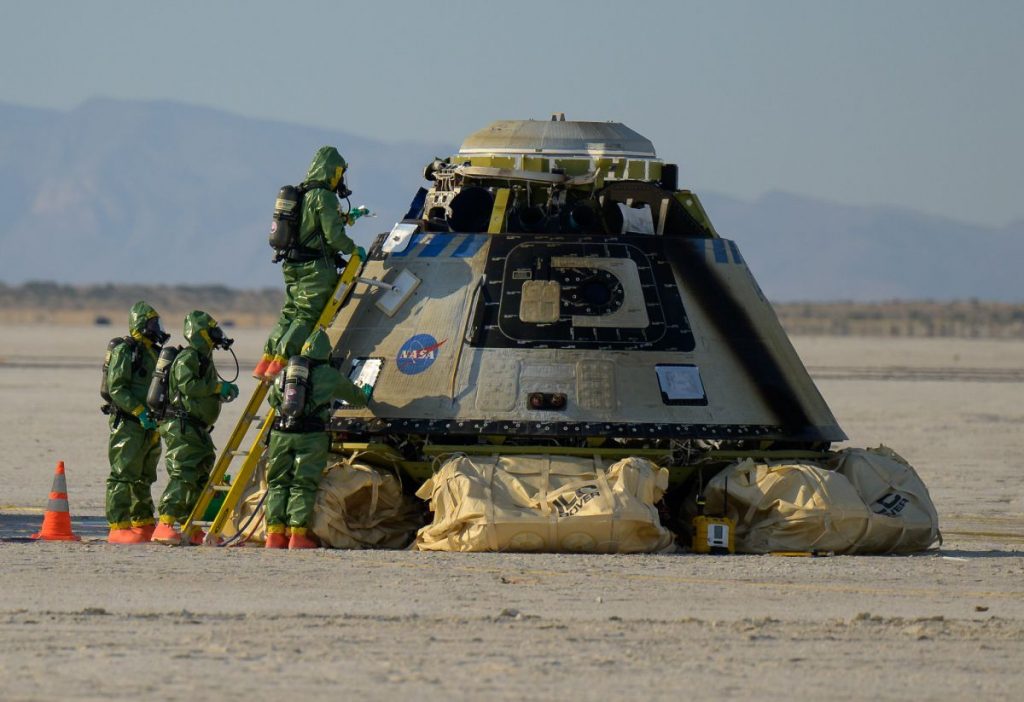Boeing’s Orbital Flight Test 2 (OFT-2) is officially a success.
That’s the verdict that leaders at NASA and Boeing gave during a press briefing on Wednesday night (May 25), a few hours after the aerospace giant’s Starliner capsule returned to Earth to wrap up OFT-2, a crucial uncrewed demonstration mission to the International Space Station (ISS).
Starliner touched down in the White Sands Missile Range, a U.S. Army facility in New Mexico, at 6:49 p.m EDT (2249 GMT) on Wednesday, hitting the desert dirt just 0.3 miles (0.5 kilometers) from its target landing point. Steve Stich, manager of NASA’s Commercial Crew Program, described the landing as “picture perfect” during Wednesday night’s briefing, saying that the test flight accomplished all of its mission objectives.
Live updates: Boeing Starliner Orbital Flight Test 2 mission to ISS
Related: Boeing’s Starliner OFT-2 test flight for NASA in amazing photos
For Boeing, the success was hard won and long delayed. The first OFT, which launched in December 2019, ended prematurely when Starliner suffered software glitches that prevented it from meeting up with the ISS. The makeup flight OFT-2 was originally supposed to launch last summer, but issues with stuck valves in Starliner’s propulsion system grounded the vehicle just hours before liftoff. After an eight-month delay, OFT-2 finally got off the ground last Thursday (May 19).
OFT-2 went smoothly from start to finish, though it did have a few minor hiccups. For example, two thrusters on Starliner’s service module failed during the orbital insertion burn, which occurred about 30 minutes after launch. And as Starliner approached the space station on Friday (May 20), an additional two thrusters needed to be shut down, this time in the capsule’s reaction control system.
In both cases, backups for each system worked as they were designed to do, and neither issue substantially affected the mission. But Starliner’s thrusters will be a focus of several post-flight checks and tests in the near future.
“Putting the vehicle through its paces on this flight is really the only way to prepare us for the crewed flight test,” Stich said. “Once we work through all the data, we’ll be ready to fly crew on this vehicle.”
Teams will soon move Starliner to a staging area to prep the vehicle for transport back to Boeing’s facilities at NASA’s Kennedy Space Center (KSC) in Florida. Mark Nappi, vice president and program manager for Boeing’s commercial crew program, said he expects Starliner to return to KSC around June 9.
“Then we’ll prep the vehicle for CTM-1,” Nappi said, referring to Starliner’s Crew Test Mission 1, the first planned flight of the spacecraft with astronauts aboard.
NASA astronaut Suni Williams, who also participated in the post-landing briefing, voiced her excitement to potentially fly on the vehicle during upcoming missions, though a specific crew rotation has yet to be determined.
Williams said that she’s ready to “kick out Rosie and Jeb and take the next flight,” referring to the two “passengers” that flew on OFT-2. Rosie is Rosie the Rocketeer, Boeing’s test dummy, clad in the company’s blue spacesuit and strapped into Starliner’s command chair. Jeb, a toy plushy strapped into a seat next to Rosie, is an astronaut character from the space agency/rocket launch simulator game Kerbal Space Program.
Rosie and Jeb were not the only things along for the ride on OFT-2. Starliner brought up nearly 500 pounds (227 kilograms) of cargo and supplies for astronauts aboard the space station and carried down to Earth about 600 pounds (272 kg) of gear.
NASA and Boeing representatives have not laid out a clear timeline for Starliner’s first crewed mission. But they have said that they’re eyeing late 2022 as a potential target.
Follow us on Twitter @Spacedotcom (opens in new tab) or on Facebook (opens in new tab).

